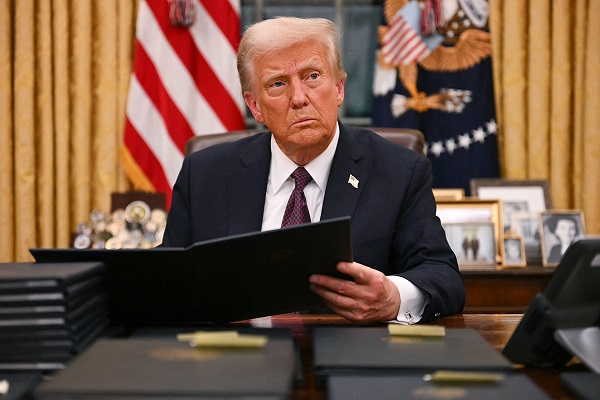Business
Canada should match or eclipse Trump’s red-tape cutting plan

From the Fraser Institute
With all eyes focused on WWT (World War Tariff), another Trump initiative was quietly put in place last week in one of the now-signature Trump “flood the zone” initiative waves.
On Jan. 31, the Trump administration published an executive order (EO) titled “Unleashing Prosperity Through Deregulation,” and as regulatory reform initiatives go, well, it’s every anti-regulatory analyst’s dream as “each new regulation issued, at least 10 prior regulations be identified for elimination.”
For reference, one of Canada’s strongest regulatory-reform efforts (in British Columbia back in 2001) only called for a 2-for-1 ratio. Although B.C.’s effort did somewhat foreshadow Trump’s, in that it created something of a DOGE (Department of Government Efficiency) when the B.C. government appointed an actual minister of deregulation to oversee the effort rather than leaving it to the bureaucracy to reform itself. And it worked. By 2004, 37 per cent of regulatory requirements in B.C. had been eliminated (exceeding the initial one-third target).
Trump’s new plan is less explicit in defining regulations, but it makes sure that new regulations cost less than the 10 regulations they replace. “For fiscal year 2025,” reads the EO, “the heads of all agencies are directed to ensure that the total incremental cost of all new regulations, including repealed regulations, being finalized this year, shall be significantly less than zero, and any new incremental costs associated with new regulations shall, to the extent permitted by law, be offset by the elimination of existing costs associated with at least 10 prior regulations.”
And Trump’s plan will put regulators in government agencies on a permanent diet, as a “total amount of incremental costs… will be allowed for each agency in issuing new regulations and repealing regulations for each fiscal year after fiscal year 2025.”
Why does this matter to Canadians?
Because, unlike those few years of B.C. regulatory reform, Canada has been wrapping itself in regulatory red-tape for decades, making our economy less competitive globally and with the United States. Between 2006 to 2018, the number of restrictive regulations in Canada grew from about 66,000 to 72,000. And according to the Canadian Federation of Independent Business, the cost of regulation from all three levels of government to Canadian businesses totalled $38.8 billion in 2020, for a total of 731 million hours—the equivalent of nearly 375,000 fulltime jobs.
Clearly, Canada has a regulatory problem—our governments generate seemingly endless spools of regulatory red tape, which keep Canadian businesses tangled in inefficiency, wasted labour and non-competitiveness. President Trump’s new regulatory reform initiative will further increase the “red-tape gap” between Canada and the U.S.
Policymakers in Ottawa and the provinces would do well to learn about Canada’s experiences with deregulatory programs and strive to match—or beat—the new U.S. regulatory reform efforts before a massive lack of regulatory competitiveness becomes a serious problem, adding insult to injury on top of World War Tariff.
Business
Canada’s critical minerals are key to negotiating with Trump

From Resource Works
The United States wants to break its reliance on China for minerals, giving Canada a distinct advantage.
Trade issues were top of mind when United States President Donald Trump landed in Kananaskis, Alberta, for the G7 Summit. As he was met by Prime Minister Mark Carney, Canada’s vast supply of critical minerals loomed large over a potential trade deal between North America’s two largest countries.
Although Trump’s appearance at the G7 Summit was cut short by the outbreak of open hostilities between Iran and Israel, the occasion still marked a turning point in commercial and economic relations between Canada and the U.S. Whether they worsen or improve remains to be seen, but given Trump’s strategy of breaking American dependence on China for critical minerals, Canada is in a favourable position.
Despite the president’s early exit, he and Prime Minister Carney signed an accord that pledged to strike a Canada-US trade deal within 30 days.
Canada’s minerals are a natural advantage during trade talks due to the rise in worldwide demand for them. Without the minerals that Canada can produce and export, it is impossible to power modern industries like defence, renewable energy, and electric vehicles (EV).
Nickel, gallium, germanium, cobalt, graphite, and tungsten can all be found in Canada, and the U.S. will need them to maintain its leadership in the fields of technology and economics.
The fallout from Trump’s tough talk on tariff policy and his musings about annexing Canada have only increased the importance of mineral security. The president’s plan extends beyond the economy and is vital for his strategy of protecting American geopolitical interests.
Currently, the U.S. remains dependent on China for rare earth minerals, and this is a major handicap due to their rivalry with Beijing. Canada has been named as a key partner and ally in addressing that strategic gap.
Canada currently holds 34 critical minerals, offering a crucial potential advantage to the U.S. and a strategic alternative to the near-monopoly currently held by the Chinese. The Ring of Fire, a vast region of northern Ontario, is a treasure trove of critical minerals and has long been discussed as a future powerhouse of Canadian mining.
Ontario’s provincial government is spearheading the region’s development and is moving fast with legislation intended to speed up and streamline that process. In Ottawa, there is agreement between the Liberal government and Conservative opposition that the Ring of Fire needs to be developed to bolster the Canadian economy and national trade strategies.
Whether Canada comes away from the negotiations with the US in a stronger or weaker place will depend on the federal government’s willingness to make hard choices. One of those will be ramping up development, which can just as easily excite local communities as it can upset them.
One of the great drags on the Canadian economy over the past decade has been the inability to finish projects in a timely manner, especially in the natural resource sector. There was no good reason for the Trans Mountain pipeline expansion to take over a decade to complete, and for new mines to still take nearly twice that amount of time to be completed.
Canada is already an energy powerhouse and can very easily turn itself into a superpower in that sector. With that should come the ambition to unlock our mineral potential to complement that. Whether it be energy, water, uranium, or minerals, Canada has everything it needs to become the democratic world’s supplier of choice in the modern economy.
Given that world trade is in flux and its future is uncertain, it is better for Canada to enter that future from a place of strength, not weakness. There is no other choice.
Business
Rhetoric—not evidence—continues to dominate climate debate and policy

From the Fraser Institute
Myths, fallacies and ideological rhetoric continue to dominate the climate policy discussion, leading to costly and ineffective government policies,
according to a new study published today by the Fraser Institute, an independent, nonpartisan Canadian public policy think-tank.
“When considering climate policies, it’s important to understand what the science and analysis actually show instead of what the climate alarmists believe to be true,” said Kenneth P. Green, Fraser Institute senior fellow and author of Four Climate Fallacies.
The study dispels several myths about climate change and popular—but ineffective—emission reduction policies, specifically:
• Capitalism causes climate change: In fact, according to several environment/climate indices and the Fraser Institute’s annual Economic Freedom of the World Index, the more economically free a country is, the more effective it is at protecting its environment and combatting climate change.
• Even small-emitting countries can do their part to fight climate change: Even if Canada reduced its greenhouse gas emissions to zero, there would be
little to no measurable impact in global emissions, and it distracts people from the main drivers of emissions, which are China, India and the developing
world.
• Vehicle electrification will reduce climate risk and clean the air: Research has shown that while EVs can reduce GHG emissions when powered with
low-GHG energy, they often are not, and further, have offsetting environmental harms, reducing net environmental/climate benefits.
• Carbon capture and storage is a viable strategy to combat climate change: While effective at a small scale, the benefits of carbon capture and
storage to reduce global greenhouse gas emissions on a massive scale are limited and questionable.
“Citizens and their governments around the world need to be guided by scientific evidence when it comes to what climate policies make the most sense,” Green said.
“Unfortunately, the climate policy debate is too often dominated by myths, fallacies and false claims by activists and alarmists, with costly and ineffective results.”

Kenneth P. Green
Senior Fellow, Fraser Institute
-

 Alberta1 day ago
Alberta1 day agoAlberta health care blockbuster: Province eliminating AHS Health Zones in favour of local decision-making!
-

 Crime2 days ago
Crime2 days agoUK finally admits clear evidence linking Pakistanis and child grooming gangs
-

 Alberta17 hours ago
Alberta17 hours agoAlberta pro-life group says health officials admit many babies are left to die after failed abortions
-

 conflict1 day ago
conflict1 day agoTrump: ‘We’ have control over Iranian airspace; know where Khomeini is hiding
-

 Alberta16 hours ago
Alberta16 hours agoCentral Alberta MP resigns to give Conservative leader Pierre Poilievre a chance to regain a seat in Parliament
-

 Business2 days ago
Business2 days agoCarney praises Trump’s world ‘leadership’ at G7 meeting in Canada
-

 Daily Caller17 hours ago
Daily Caller17 hours ago‘Not Held Hostage Anymore’: Economist Explains How America Benefits If Trump Gets Oil And Gas Expansion
-

 Business2 days ago
Business2 days agoTrump family announces Trump Mobile: Made in America, for America


